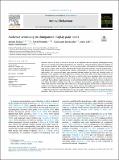Audience sensitivity in chimpanzee display pant hoots
Abstract
Audience effects are key in studies of animal social cognition and are typically investigated during directed social interactions. Male chimpanzees regularly perform aggressive displays in the presence of others, often targeting a specific group member, and combine this agonistic behaviour with acoustic signals. Here, we were interested in whether the production and structure of pant hoots, a long-distance signal, were influenced by audience composition (i.e., presence and absence of specific individuals). We investigated pant hoots produced during displays by adult and sub-adult males of Budongo Forest, Uganda. We found that males overall called more often when their preferred social partners and females were absent from the party, as well as when more dominant males were present. We then separately analysed the four phases of pant hoots - introduction, build-up, climax, and let-down - and found that audience composition and social context could often explain the presence or absence of each phase. In addition, displays were often accompanied by drumming, especially by older males and when male audiences were small. Our study adds to the growing body of literature on audience effects and other social factors and shows their impact on the structure of a sophisticated vocal sequence, which enhances the communicative capacity in a species with limited vocal control.
Citation
Soldati , A , Fedurek , P , Dezecache , G , Call , J & Zuberbühler , K 2022 , ' Audience sensitivity in chimpanzee display pant hoots ' , Animal Behaviour , vol. 190 , pp. 23-40 . https://doi.org/10.1016/j.anbehav.2022.05.010
Publication
Animal Behaviour
Status
Peer reviewed
ISSN
0003-3472Type
Journal article
Description
The study was funded by a St Leonard College Inter-University scholarship awarded to JC and KZ, the Swiss National Science Foundation awarded to KZ (310030_185324), and individual grants from Swiss universities and St Leonard Santander Mobility awarded to AS.Collections
Items in the St Andrews Research Repository are protected by copyright, with all rights reserved, unless otherwise indicated.

